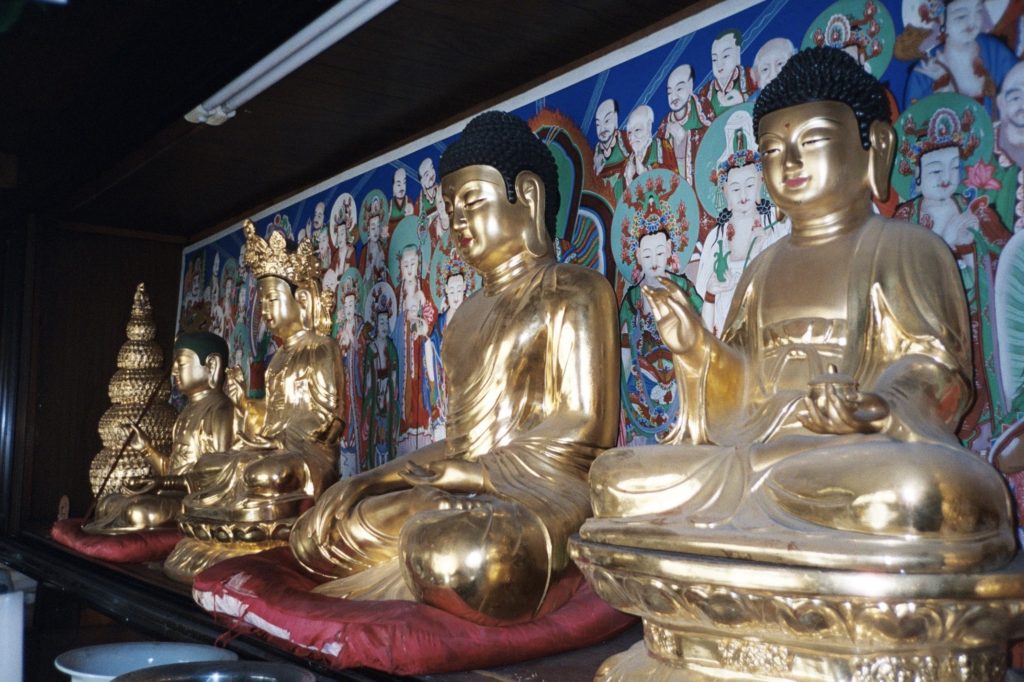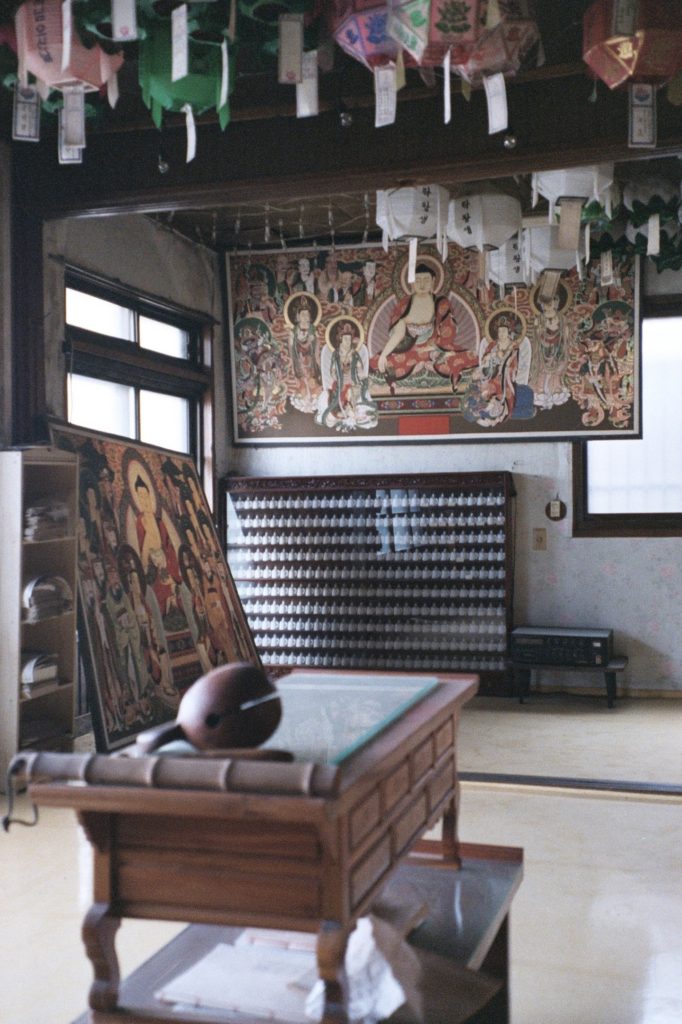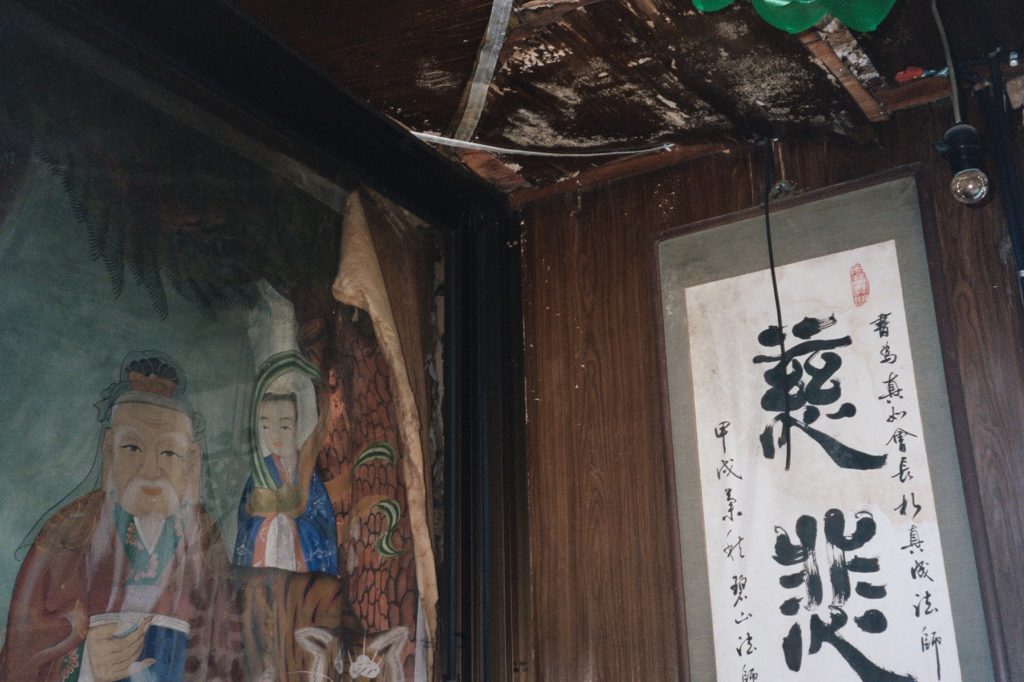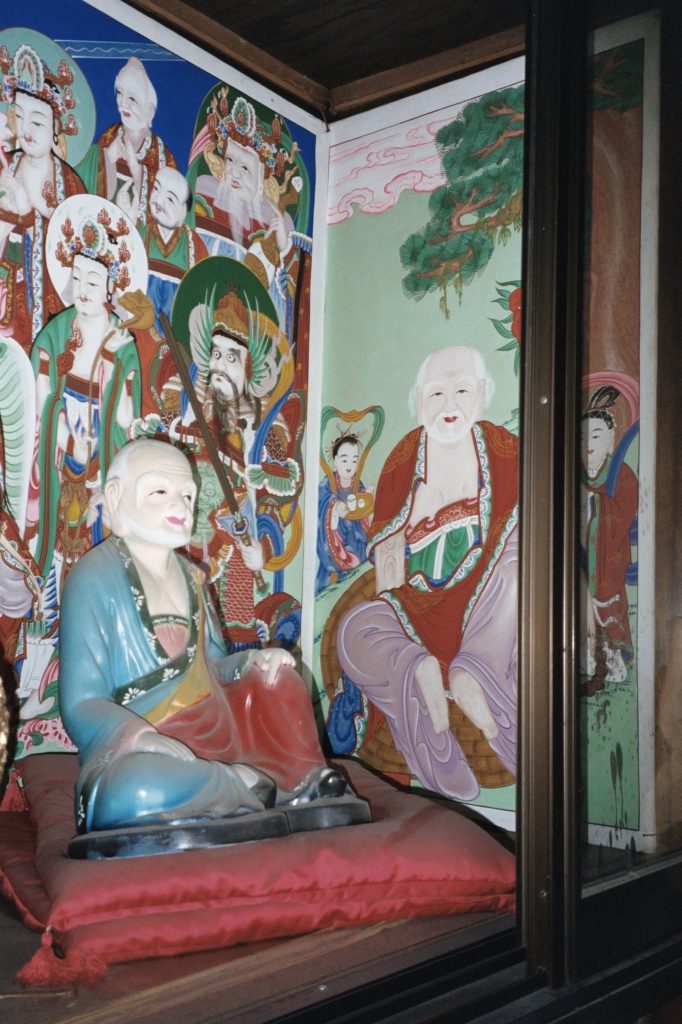Paying Respects to the Dusty Buddhas of Samhong-sa
Written by Ryan Berkebile.
Once I discover a neighborhood in the initial stages of a demolition operation, my documenting process begins. The primary motivation for exploring abandoned neighborhoods in Korea is to chronicle the area before demolition workers erase it from people’s memory. Depending on the size of the redevelopment zone, I make numerous visits to the location, using film cameras and an iPhone to shoot scenes that capture my interest. It is quite unbelievable what people leave behind as they vacate their residence or workplace. School annuals, wedding photos, bankbooks, hanbok (한복, traditional Korean clothing), and even graduation certificates are typical examples of personal items that I find while investigating neighborhoods destined for demolition. Abandoned residents, stores, and even shaman’s houses (무당집, mudangjip) are a dime-a-dozen to discover in a jaekaebal jiyeok (재개발 지역) or redevelopment zone. But finding a fully furnished Buddhist temple left unoccupied years ago is unusual. This discovery ranks as one of my most exciting, saddening, and also insightful finds as an urban explorer. I have found that urban exploration (also known as “urbex”) unveils the absurd situation we call modern living; the scenes shift from the comic (and everything in between) to the profound quickly.

My experience with this abandoned Buddhist temple would fall somewhere between tragedy and profundity. It does not harm to divulge the temple’s location because it is already gone. Samhong-sa (삼홍사) was a Buddhist temple located on a hill behind the Korea National University of Arts in northern Seoul. Demolition workers, or perhaps scavengers, came and took the paintings (탱화, taenghwa) and Buddha statues of Samhong-sa. On my third visit to the place, my urbex spidey senses tingled as I assessed the temple’s open gate, a sure sign visitors with intentions other than photography had paid a visit. Before that day, the door had been impenetrable. The only way to access the temple was by scaling the wall from the abandoned house next door. Samhong-sa was not a grand, tourist-friendly temple like Jogye-sa (조계사) or Haein-sa (해인사). It was a small house transformed into a place of devotion. The temple provided a refuge for the Buddhists living in the Imun-1-dong neighborhood.

Crossing the threshold, I saw the doors to the Great Buddha Hall (대웅전, daeungjeon) splayed open. Inside I found countertops, dedication cards, and paper lotus lanterns littered on the floor. One lone painting survived the pillage, but debris obscured it from a clear view. It was disappointing on two levels. As a Buddhist, it was difficult to see the beautiful, inspirational images disappear in such a careless manner. The second prick of sadness came as an urban explorer. Samhong-sa was a beautiful place weirdly frozen in time. As I mentioned earlier, it is atypical to find abandoned Buddhist temples in Korea, and even rarer to find one left behind with lots of stuff inside. This location struck me twice as someone who identifies with each group. From my experience, Buddhists and urban explorers appreciate, and try to express honesty and respect for the impermanence of life. However, each group has its ways and methods of showing it.
Anyone who has spent a significant amount of time at a Buddhist temple in Korea will notice the immaculate interior and exterior of its buildings. Resident monks work tirelessly with laypeople volunteers to maintain a spotless haven for visitors and seung-ga (승가, Buddhist monks). Located in a neighborhood that was almost completely clear of residents, I scouted outSamhong-sa a few times before attempting to get in because I could not get a full sense of whether it was empty. One day, I scouted it out from the yard of the abandoned house next door. The Great Buddha Hall was intact. It seemed clean and cared for; however, the residential quarters told a different story. There was a gaping hole in the roof where the monks or nuns used to eat and sleep, and it had caved in long ago. The wood sticking out was weathered and had been exposed to the elements for quite some time. Yet, despite this visible sign of desertion, I saw old shoes lined up in front of the place, which freaked me out a bit. Maybe someone was squatting in the Great Buddha Hall, tending the site to protect the Buddhist art and statues? I worked up the nerve to scale the fence and scope out the caved-in building and forgotten shoes before taking a look inside the Great Buddha Hall. I tried to peek through the window of the caved-in building but could not see inside. My imagination ran into overdrive, envisioning the ruined portion of the temple as the final resting place for a monk or nun who died alone and isolated from society. I let go of these thoughts, returning to the present moment and moved on towards the Great Buddha Hall.

As I opened the door, there were no signs of a person squatting or caring for the place. It was unfathomable that a tranquil and peaceful place like Samhong-sa would be forgotten and left behind. The living quarters appeared trashed, but I held out for hope that a devoted practitioner would periodically come by to look after the temple. After my mind settled, it became clear nobody had been here to bow, chant, pray, or meditate for a long time. Dust lingered in the air and coated cushions, tables, and lotus lanterns.Probably the most noticeable grime glazed the golden Buddha and his three accompanying bodhisattvas on the central altar. The roof’s water damage had seeped years of moisture onto a hanging calligraphy scroll and devotional painting for the Sanshin (산신, mountain spirit). Despite Samhong-sa’s neglected state, the Great Buddha Hall offered a tranquil space to those who visited. Underneath the filth, its true nature shined. I felt a sense of peace in front of the murky Buddha and bodhisattvas. I imagined they sat waiting serenely for anyone seeking refuge from suffering, even if only to escape the weather. I received a thoughtful reminder of the precarious nature of left from the Buddha and his bodhisattvas that day I saw them gone.

The Author
When Ryan Berkebile is not taking pictures of abandoned neighborhoods, he likes to write blog posts for his website, Long Distance Runner. You can see what he has been up to at longdistancerunner.org and on Instagram @l0ngdistancerunner and @naturaryan1600.





